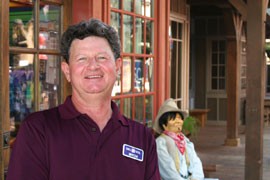Cronkite News has moved to a new home at cronkitenews.azpbs.org. Use this site to search archives from 2011 to May 2015. You can search the new site for current stories.
Boost in state funding spurs national tourism campaign
PHOENIX – Those walking along Chicago’s chilly streets in the coming months will see a saguaro cactus, the Grand Canyon and Sedona’s red rocks on buildings and billboards.
With words like “monumental,” “unexpected” and “timeless,” the ads will invite people to escape to Arizona.
“The idea is to get your attention with the iconic images,” said Sherry Henry, director of the Arizona Office of Tourism.
It’s part of a national campaign made possible by a $7 million appropriation from the state’s general fund.
Beginning in November and running through March, the ads also will appear in nationwide publications such as Travel Leisure and Condé Nast Traveler, as well as in other print, outdoor and online media. Arizona will be featured on the homepage of the Orbitz website.
The campaign includes a special emphasis on the target markets of Chicago, Minneapolis and Denver.
“We haven’t been able to do that in almost three years,” Henry said. “And it’s just like any other business. If Coca-Cola doesn’t advertise, who’s going to get market share? Pepsi-Cola.”
The office had been funded largely by a share of hotel, restaurant and amusement taxes collected around the state, as well as a share of American Indian gaming proceeds and a hotel and car rental tax in Maricopa County intended for marketing that region.
But in 2010, state lawmakers addressing the budget deficit removed the Tourism Funding Formula that provided the largest share of the office’s budget. The formula accounted for $14.4 million of the office’s $27.4 million budget in fiscal 2010.
Gov. Jan Brewer pushed for the $7 million general fund appropriation in her fiscal 2013 budget to help boost tourism. That brought the office’s budget to $20.2 million for the current fiscal year.
Henry said investing in tourism pays off.
“The exposure generates additional visitors, visitors generate visitor spending, visitor spending generates taxes,” she said. “The travel dollar trickles all the way down so that everybody in the state of Arizona is basically affected.”
The 37.6 million overnight visitors to Arizona in 2011 spent $18.3 billion, generating approximately $2.7 billion in local, state and federal tax revenues, according to the Office of Tourism.
Mitch Woulfe, president of Scottsdale’s Old Town Merchants Association and owner of Del Sol, a T-shirt shop, said attracting more visitors means more business and more jobs.
“It would help Scottsdale immensely to have more funding for marketing Arizona,” Woulfe said.
Professor Dennis Hoffman, director of the L. William Seidman Research Institute at Arizona State University’s W.P. Carey School of Business, said that national marketing is valuable because the tourism industry captures billions in spending for the state.
“Investments in the Arizona Office of Tourism clearly pay dividends,” Hoffman said. “The question is should we be doing even more?”
Jim Rounds, senior vice president and senior economist with Elliott D. Pollack and Co., said that Arizona may have lost some marketing momentum when the state funding dried up and that it will take some time for the new effort to gain traction.
He said the Office of Tourism and various tourism entities, including chambers of commerce and economic development organizations, will have to fight to maintain or increase state funding.
“It takes everybody on the same page to make this work,” Rounds said. “What they need to do with lawmakers is provide a more cohesive message and explain more clearly why this benefits the state as a whole.”










